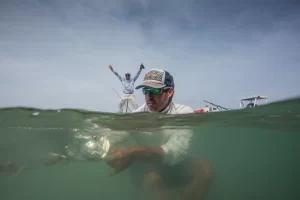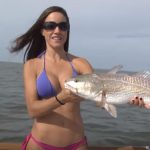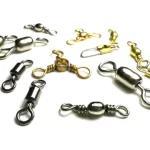You’ve secured your dream saltwater destination, booked your lodge, and arranged your guide. You’ve even managed to clear your schedule and purchase those plane tickets. Now, as you contemplate the merits of an aisle versus a window seat, a crucial question arises: what exactly do you pack for a tropical saltwater fly-fishing expedition?
The transition from freshwater to saltwater fly fishing, especially for species like bonefish, tarpon, snook, and permit, can be daunting. With 15 years of experience photographing fly fishing worldwide and managing guide teams, I’ve seen countless anglers arrive unprepared, armed with gear ill-suited for the challenges of the tropics. Your trusty five-weight and cold-water trout line simply won’t cut it in the Caribbean’s sweltering, salty environment.

While reputable lodges and guides provide packing lists and gear advice, this overview will help you prepare for your first saltwater adventure, particularly in the Caribbean.
1. Clothing: Sun Protection is Paramount
- Sun Shirts: Long-sleeved, hooded shirts are essential. They protect against intense sun exposure, which is crucial on the flats where shade is scarce.
- Quick-Drying Bottoms: Opt for quick-drying long pants or shorts. If choosing shorts, be diligent with sunscreen and bring a towel for extra coverage.
- Hat: A ball cap or broad-brimmed sun hat will shield your face and neck.
- Gaiter: Protect your neck and ears from the sun.
- Rain Jacket: Even on seemingly clear days, sudden storms are common. Consider rain pants or bibs for extended wet conditions.
- Lightweight Socks: If you plan on being barefoot on the boat, consider light colored socks to protect your feet from sunburn and hot surfaces.
2. Rods, Reels, and Lines: Tailored for the Tropics
- Saltwater Fly Rods: A standard setup includes an 8-weight for bonefish, a 9-weight for permit, and a 10-weight for tarpon. For tarpon enthusiasts, consider an 11- or 12-weight.
- Saltwater Reels: These reels are anodized and sealed to resist salt and sand. They also feature robust drag systems to handle powerful saltwater species. Ensure your reels can hold at least 200 yards of 20-pound backing for bonefish and permit, and 250+ yards of 30- to 50-pound backing for tarpon.
- Lines: Weight-forward floating lines designed for tropical waters are essential. Avoid cold-water lines, which will become limp and sticky in the heat. For tarpon fishing in deeper waters, an intermediate line is beneficial.
- Reel Maintenance: Rinse reels with fresh water after each day and thoroughly clean and lubricate them post-trip to prevent corrosion.
3. Leaders and Tippet: Precise Terminal Tackle
- Bonefish Leaders: 9 to 12 feet long, ending in 10- or 12-pound tippet.
- Permit Leaders: 9 to 14 feet long, ending in 16- to 20-pound tippet.
- Tarpon Leaders: Many anglers prefer custom leaders, but a straight piece of 60- or 80-pound fluorocarbon or monofilament is often sufficient. Consult your guide for specific recommendations.
- Tippet Spools: Bring 12-, 16-, and 20-pound tippet for leader adjustments.
- Wire Leaders: A few wire predator leaders are useful for targeting barracuda.
4. Flies and Fly Boxes: Organized and Protected
- Saltwater Flies: Crabs, shrimp, and baitfish imitations are common. Consult your lodge or guide for specific recommendations. Essential patterns include chartreuse-and-white Clouser minnows, Gotcha shrimp, and raghead crabs.
- Fly Boxes: Separate fly boxes for each fly type are ideal for organization. Alternatively, segment flies within a single box. Choose boxes that secure flies and keep them dry.
- Fly Care: Rinse saltwater-exposed flies with fresh water and dry them before storing them to prevent rust.
5. Essential Accessories: Protection and Utility
- Sunglasses: Polarized wrap-around sunglasses protect your eyes from sun and glare. Green lenses are ideal for inshore, and blue lenses for offshore. Always carry a spare pair.
- Pliers: Sturdy fishing pliers for hook removal, knot tightening, and tippet cutting. Choose pliers with a belt-mounted holster. Rinse and dry them after each trip.
- Wading Boots: Boots that offer ankle support, drain quickly, and are durable enough for various underwater terrains. Neoprene socks can add comfort.
- Waterproof Pack: A waterproof pack, such as the BOTE Highwater Backpack, is essential for protecting gear from rain and splashes.
- Hydration: Bring electrolyte drinks (like LMNT) and plain water to prevent dehydration. Electrolyte gummies are a convenient alternative.
6. Miscellaneous Considerations:
- Listen to Your Guide: Their expertise is invaluable.
- Embrace New Techniques: Be open to trying different fishing methods.
- Enjoy the Experience: Your first saltwater trip is a unique adventure.
By preparing thoroughly and trusting your gear, you’ll be well-equipped to fully immerse yourself in the thrilling world of tropical saltwater fly fishing.
Image/Source: WOS





